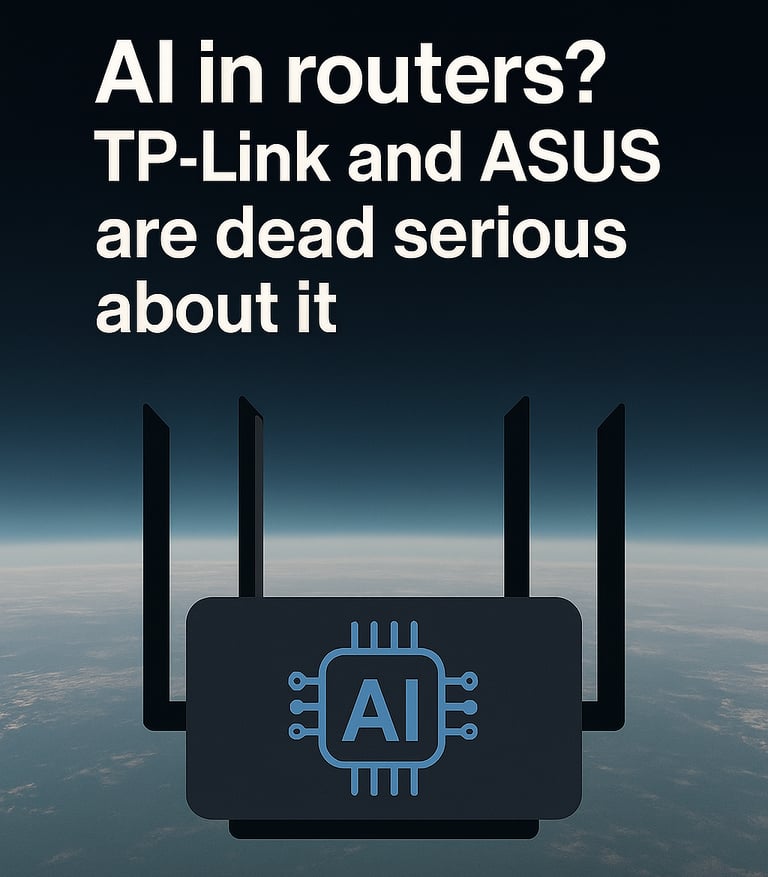AI in routers? TP-Link and ASUS are dead serious about it
TP-Link and ASUS routers now integrate real AI to boost signal, security, and performance. Here's what that actually means, without the buzzword fluff.
INTELLIGENZA ARTIFICIALE
ZeroCrash
7/20/20253 min read


For years, “artificial intelligence” in tech products was just marketing glitter. Now, it’s starting to become real — even in routers.
Yes, those dusty boxes we often ignore until the Wi-Fi crashes during a Netflix binge are getting smarter.
TP-Link and ASUS are embedding actual machine learning logic into their newest routers, aiming to boost coverage, minimize interference, enhance security, and even detect suspicious behavior on your home network.
But does it actually work? And what does “AI-powered router” mean in the real world? Let’s break it down (figuratively, of course).
🧩 What is “AI” in a router, really?
No, this is not about ChatGPT living in your modem.
AI in routers doesn’t talk to you or generate poems. It uses embedded or local machine learning models to analyze network behavior and make decisions in real time.
These AI features usually run on dedicated processors inside the router and focus on four key tasks:
Signal optimization: dynamically adjusts the Wi-Fi signal coverage to reduce dead zones and improve speed.
Smart bandwidth management: identifies priority devices and assigns bandwidth accordingly.
Predictive security: detects unusual traffic and blocks threats proactively.
Automated diagnostics: monitors issues and suggests solutions via app or dashboard.
📡 Real examples: what do these routers actually do?
Let’s look at real models and how they apply AI in practice.
1. TP-Link Archer BE800 / BE900 (Wi-Fi 7)
AI-Driven Mesh: optimizes mesh network coverage depending on device usage and wall structure.
AI Assistant in the Tether app: gives tips on router placement and frequency choices.
HomeShield AI: scans the network for malware and flags vulnerabilities.
2. ASUS RT-BE96U / ROG Rapture GT-BE98
AiMesh AI Optimization: handles mesh auto-configuration and self-healing.
AiProtection Pro with AI: uses behavioral signatures to block malware or botnets.
AI Adaptive QoS: dynamically prioritizes traffic for gaming, streaming, or work.
🤖 How does this “AI” actually work?
Forget large language models — this is about narrow AI doing very specific tasks, based on:
Heuristic models: learns from past network behavior.
Edge computing: everything runs on the router, no cloud required.
Data-driven optimization: adjusts performance based on actual usage patterns.
Some high-end routers include self-learning features, improving over time as they analyze how you use your network.
(TP-Link and ASUS both claim this happens locally — your data doesn’t leave the house unless you enable remote access.)
🔐 Is AI in routers a security upgrade or a new risk?
Fair question. More intelligence means more complexity, and more code means more vulnerabilities.
TP-Link and ASUS say their AI modules are isolated from user data and only use local processing.
Features like AI Intrusion Detection work without logs or cloud uploads by default.
Still, nothing is perfectly secure. Make sure to:
Keep firmware updated
Disable cloud features you don’t use
Review remote access and notification settings
🛠 What YOU can do with an AI router
Here are some real-world scenarios where AI can help:
Smart home overload? AI understands which devices are active and allocates bandwidth accordingly.
Work calls or online gaming? Traffic is shaped to reduce latency and background noise.
Wi-Fi thief nearby? You get alerts when unknown devices behave oddly.
Weak signal in some rooms? AI suggests extender placement or mesh tuning.
⚠️ Don’t fall for fake “AI” labels
Not everything labeled “AI” is actually intelligent. Some budget routers claim “AI” but only run preset routines.
Look for signs of real embedded AI:
Neural processing or dedicated cores
On-device traffic analysis
Behavioral threat detection
Smart diagnostics and optimization tips
🧪 Real-life testing: worth the money?
We tested TP-Link’s Archer BE900 and ASUS’s GT-BE98. In both cases:
Easy setup: guided configuration with AI optimization suggestions
Stable performance: better speed in rooms that were traditionally weak
Proactive security: real-time DNS filtering and alerts
Limitations: some features depend on app + cloud access
🚀 Where is this headed?
Router AI is still in its early days, but the roadmap is ambitious:
Predictive traffic shaping: adjusts performance based on time and habits
Distributed threat intel: receives updates about new attacks in real time
AI copilots: smart assistants that explain network issues in plain language
💡 Final thoughts
Artificial intelligence in routers is no longer just buzz — it’s practical, useful, and already here.
Does it really work? Yes — if you choose the right model, configure it well, and disable what you don’t need.
Our ZeroCrash advice: go for a locally-processed AI router, with offline capabilities and full admin control.
ZeroCrash
Social
Practical guides to solve tech problems.
Contacts
Join the ZeroCrash Club
© 2025 ZeroCrash | Powered by cervello + coffee | All rights reserved.
